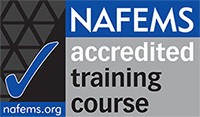| ID | Competence Statement |
| DVkn1 | State Newton's 2nd Law or, equivalently, the d'Alembert Force Method. |
| DVkn2 | Define the relationships amongst instantaneous acceleration, velocity and distance. |
| DVkn3 | Define the basic equation for Kinetic Energy. |
| DVkn7 | State the Mass Moment of Inertia in general and define it for a circular cylindrical rod rotating about an end. |
| DVkn9 | Define the terms frequency, period, phase angle, and amplitude for a harmonic time signal |
| DVkn10 | State the typical matrix structure of the discrete differential equation system for linear MDOF systems |
| DVkn11 | Define the terms free and forced vibration |
| DVkn12 | State typical values for damping in various engineering structures. |
| DVco5 | Explain the term Instantaneous Centre of Zero Velocity. |
| DVco9 | Explain the term Conservative Forces, Potential, and Strain energy |
| DVco12 | Explain the use of physical, analytical and mathematical models in a structural dynamics modelling process. |
| DVco13 | Discuss the full discrete linear differential Equation of Motion in matrix terms and explain the terms Free Response and No Damping. |
| DVco14 | Explain the derivation of the General Matrix Eigenvalue Problem (characteristic equation) from the Equation of Motion. |
| DVco15 | Explain different physical forms of Dynamic Loading (Excitation) in a Force Response analysis. |
| DVco16 | Explain Harmonic, Periodic, Transient, and Random time response. |
| DVco18 | Explain steady-state response for harmonic excitation. |
| DVco19 | Explain the term complex Frequency-Response Function, Magnification Factor, and Phase Angle in relation to frequency ratio and damping. |
| DVco20 | Discuss the term Natural Frequency in relation to a continuum and a discretized system. |
| DVco21 | Discuss the phenomenon of Resonance. |
| DVco22 | Explain the terms Mode Shape/Eigenvector, Modal Mass, Modal Damping, and Modal Stiffness Factors. |
| DVco25 | Discuss the characteristics of mass and damping matrices. |
| DVco26 | Describe the difference between Viscous, Dry-Friction (Coulomb), and Hysteretic Damping. |
| DVco27 | Describe the effect of damping on natural frequencies and resonance. |
| DVco28 | Describe Free Vibration of undamped and damped systems. |
| DVco29 | Explain the Logarithmic Decrement Method. |
| DVco30 | Discuss the concept of mass and stiffness proportional (Rayleigh) damping. |
| DVco33 | Discuss the steady state and total response of a damped system subjected to harmonic excitation. |
| DVco34 | Describe the terms Intertia force, Damping force and Stiffness force. |
| DVco35 | Discuss the integral equation for element mass, highlighting the variables which it is dependent upon. |
| DVco37 | Describe the terms Lumped mass matrix and Consistent mass matrix and identify which formulation is appropriate to elements being used. |
| DVco38 | Discuss various strategies for extraction of eigenvalues and mode shapes, including Lanczos and Subspace Iteration. |
| DVco39 | Discuss how the solution of the Free Vibration Problem depends upon a truncation of range of natural frequencies and mode shapes. |
| DVco40 | Explain methods to compare Experimental with Analytical Modal Analysis data (e.g., MAC, COMAC). |
| DVco42 | Explain why in a free vibration problem, an analysis system may report 6 frequencies of small magnitude. |
| DVco45 | Contrast Modal Superposition and Direct Time Integration methods for transient response analysis. |
| DVco47 | Contrast mesh density requirements in static and dynamic problems. |
| DVco48 | Discuss why joints can prove to be problematic in a dynamic analysis. |
| Dvco53 | Discuss frequency range obtainable by FE modal analysis. |
| DVap1 | Employ Free Body Diagrams effectively, showing initial and final conditions where appropriate. |
| DVap3 | Employ a range of post-solution checks to determine the integrity of dynamic FEA results. |
| DVap5 | Employ an analysis system for the determination of natural frequencies and mode shapes. |
| DVap6 | Employ an analysis system for the determination of steady state response and frequency response function for a periodic excitation |
| DVap11 | Employ an analysis system for the determination of dynamic stresses, where appropriate. |
| DVap13 | Illustrate the approximate nature of finite element analysis, through dynamic examples chosen from your industry sector. |
| DVan1 | Analyse the results from dynamic analyses and determine whether they are consistent with assumptions made and the objectives of the analysis. |
| DVan2 | Analyse the results from and modelling for dynamic analyses by comparing measured modal data (EMA) with those obtained from FE analytical modal analysis. |
| DVsy1 | Prepare a dynamic analysis specification, highlighting any assumptions relating to geometry, mass distribution, loads, boundary conditions, damping, and material properties. |
| DVsy2 | Plan a dynamic analysis, specifying necessary resources and timescale. |
| DVsy3 | Prepare quality assurance procedures for dynamic finite element analysis activities within an organisation. |
| DVsy4 | Specify ancillary Pilot Studies and complementary Experimental Studies, where appropriate. |
| DVev1 | Select appropriate idealisation(s) for components / structures, which are consistent with the objectives of the dynamic analyses. |
| DVev2 | Assess the significance of neglecting any feature or detail in any dynamic idealisation. |
| DVev3 | Assess the significance of simplifying geometry, material models, mass, loads or boundary conditions and damping assumptions on a dynamic analysis. |
| DVap7 | Employ an analysis system for the determination of transient response in a range of linear and nonlinear systems. |
| DVap8 | Employ an analysis system for the determination of seismic response in a range of linear and nonlinear systems. |




